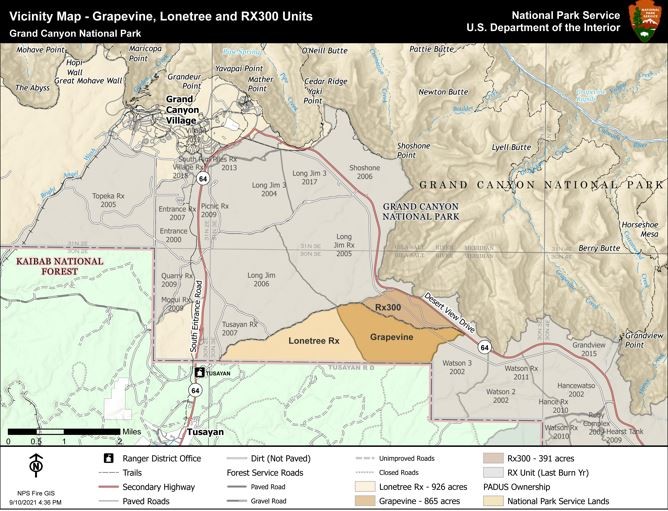News Release: Prescribed Fire Planned for South Rim of Grand Canyon beginning November 16
November 16, 2021
GRAND CANYON, Ariz. —Grand Canyon National Park fire managers—working with resources from Lake Mead National Recreation Area, Zion National Park and the Kaibab National Forest anticipate initiating prescribed fire treatments as early as tomorrow, November 16, 2021, on the South Rim, as weather and fuel moisture conditions allow.
On Tuesday, November 16, ignitions may occur on the RX 300 Project and continue through Wednesday, November 17. The RX 300 project area totals an area of 391 acres and is bound by Highway 64 as the north boundary, the E4/Long Jim Canyon Road is the eastern and southern boundary, and a closed two-track road as the west boundary. 
Smoke from the RX300 Project will be most visible during ignition operations and will likely gradually diminish after ignitions are completed. Smoke impacts are most anticipated for the Town of Tusayan and along Highway 64 (Desert View Drive). Smoke may also impact the Grand Canyon Village and the inner canyon, particularly near the ignition area. Fire managers are working with the Arizona Department of Environmental Quality-Smoke Management Division to reduce and mitigate potential smoke impacts.
Drivers traveling along Desert View Drive are advised to move along the highway slowly with their lights on, avoid stopping in areas where fire personnel are working and follow directions of signs and personnel. There are no road closures anticipated, but traffic control or one-way traffic may be implemented if smoke impacts cause unsafe driving conditions.
Prescribed fires play an important role in decreasing risks to life, resources, and property. Fire managers carefully plan prescribed fires, initiating them only under environmental conditions that are favorable to firefighter and visitor safety and achieving the desired objectives. Prescribed fire objectives include reducing accumulations of hazard fuels, maintaining the natural role of fire in a fire-adapted ecosystem, and protection of sensitive natural and cultural resources.


